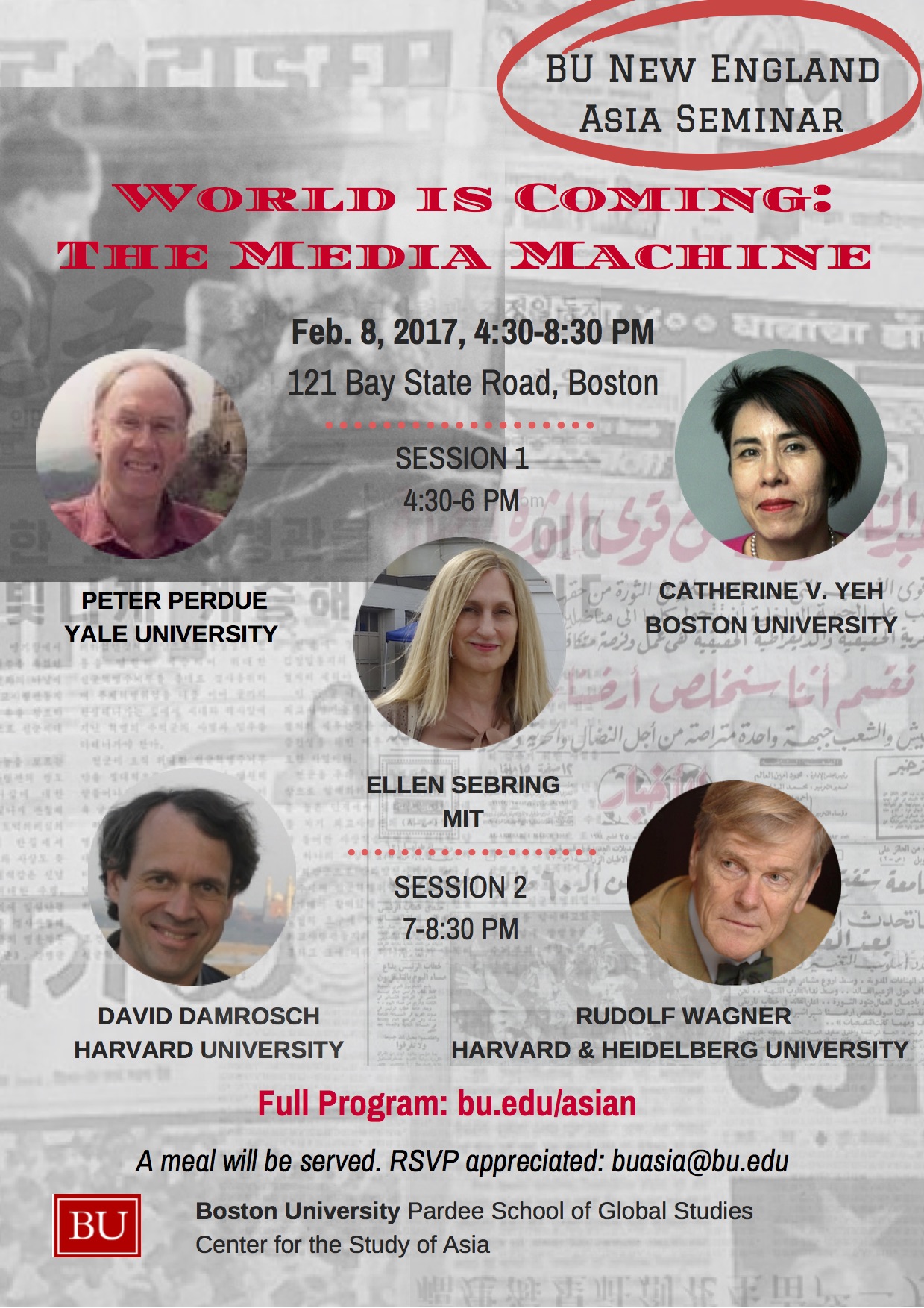BU New England Seminar: World is Coming: The Media Machine
DATE: Feb. 8, 2017
TIME: 4:30-8:30 PM
LOCATION: 121 Bay State Road, Boston University

The world has been with us since human life began. It was all pervasive, in the DNA shared with others, the domesticated plants and animals, the undomesticated pests, the goods cherished, and the stories told, and the “others” envied, fought, or emulated. It became part of the ever-present mental horizon only with the dramatic increase in the mobility of information, goods and people since the early nineteenth century. In this process media – books, newspapers, images, moving images, and digitized information – played a key role in making “the world” a daily reality for an ever wider range of people.
The New England Asia Seminar will address this role with four speakers.
4:30-6:00 pm First Session:
Peter Perdue (Yale University)
Ellen Sebring (MIT):
“Visualizing the Boxer Rebellion and its Enemies”
John Dower and his colleagues created the Visualizing Cultures website at MIT to explore contacts between Asia and the West through the use of online media combined with visual essays, uniting text and imagery in a new form of historical interpretation. We have now completed several new units, using abundant digitized material from Chinese and Western sources, to explore the implications of the Boxer Rebellion of 1900 for China and the global imperialist world. We will present excerpts from these units and discuss how they contribute to new ways of interpreting global historical events.
Catherine V. Yeh (Boston University):
“The World in Moving Pictures: Medium, Message, and Image of East-West Relations in Griffith’s Broken Blossoms or The Yellow Man and the Girl (1919)”
The new media of motion pictures, since its inception in the late 19th century, helped create a new way to present and experience the world. In structuring the world through themes, characters, plots and stories, the world was “made real,” concrete and personal, it became a new mental place. In its own way, each film structures a discussion about the local/world, and through this, the perspectivized world it showed changed the genre into a powerful artistic medium to engage with a global audience on multiple levels. Looming large and still being at the core is the issue of cultural identity in the context of theformation of a world civilization governed by a set of shared values. This talk will focus on the ways in which the formation of this notion of a world civilization was presented through a discussion of East-West relationship in D.W. Griffith’s silent film Broken Blossoms or The Yellow Man and the Girl (1919).
Buffet Dinner
7:00-8:30 pm Second session:
David Damrosch (Harvard University):
“Asian Writing in the Global Mediascape”
New media have always has a profound impact on writers, at once unsettling and liberating. The invention of writing in ancient West Asia already had such effects, which took on dramatically new forms with the rise of a truly global mediascape over the past century. This talk will look at ways in which the world reaches into writers’ awareness and the ways in which they in turn reach out to the wider world, with two East Asian cases in point: the Chinese “New Culture” movement’s magazine New Youth in the early twentieth century, and the Seoul-based internet collective Young-hae Chang Heavy Industries today.
Rudolf Wagner (Heidelberg University/Harvard University):
“The Shared Agenda of the Newspaper: Bringing the World Home”
The global spread of the newspaper medium during the 19th and early 20th centuries followed a shared agenda: To bring the world of today to the reader. This agenda is visible in the titles chosen for the papers, the news-sharing networks developed, and the attitudes displayed by early journalists. It fueled the development of ever faster communication. The implantation of this agenda reflects an asymmetry in information and innovation that was perceived and released substantial energies to deny or reverse it.